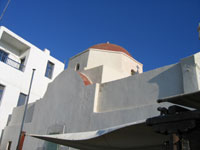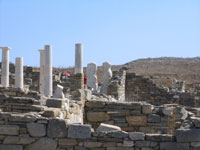
- Page 1: Venice (Italy) - Athens (Greece) - Mykonos - Delos - Santorini
- Page 2: Rhodes - Messina/Taormina (Sicily) - Naples/Pompeii (Italy) - Sorrento
- Page 3: Barcelona (Spain) - Park Gruëll - La Sagrada Familia - New friends - An alternate look
- return to joehoffman.com

Atlantis Venice to Barcelona Cruise
August 27 to September 6, 2004
Here I am, dressed for work and carrying the tools of my trade for this trip (a video camera, exra batteries, tapes, sunscreen, local map, and my ever-present digital still camera). By the end of this trip, I will have visited three countries, eight port cities, four archealogical sites, and countless cafes. I also have a nice tan and funny triangular tan lines on my feet from my sandles.
The pictures that follow document most of the trip in chronological order. You'll be able to see the places I visited and some of the really great people I met.
If you have comments, or see a picture you really want, drop me an email by clicking here (sorry to email address is masked to prevent more spam).

August 26 - 27
I arrived in Venice after 20 hours of traveling from Los Angeles to London Heathrow, transferring to London Gatwick via a 90 minute bus ride, waiting three more hours, then flying into Marco Polo at 10 at night. At that hour, there are no money exchanges open, and the one ATM in the airport didn't work. I was now part of a group of 12 Atlantis team members looking for cabs for us and our bags...huge bags.
Thankfully, we were staying in Mestre, outside of Venice, so we didn't need to worry about lugging our bags from cab to vaporetto to hotel in the middle of the night. The next morning, Leo and I set out for Venice proper with cameras and guide in hand.

August 28
We arrived in Athens after a day's sail from Venice. Because the cruise ship port at Piraeus was filled with vessels being used as floating hotels (including the gigantic Queen Mary 2), we were forced to dock at an industrial port a few minutes bus ride away. The shuttles dropped us off at the Piraeus subway station which we then took into the city.
First stop, Acropolis. We hailed a cab to the top as it was getting late in the day and the heat and humidity made the hike up the hill look very unpleasant. A two euro ride later, we were there.
It's one thing to see the Parthenon in books and magazines, but to stand in front of it, sun glaring off the marble, is almost indescribable.
So, I'll let the images speak for me...
Click here to view some panoramic images I assembled of Athens.

August 30
Mykonos was a beautiful break from the smog and noise of Athens. The town, although a bit touristy, is still quaint and pleasant. I didn't get to see the famous beached of Paradise on the other side of the island, opting instead to visit the island of Delos (see next box).
That night, we found a nice restaurant in town, and by the time we had finished our meal had convinced about eight more tables of "boat people"* to eat there as well.
Here's a few images of Mykonos...
*boat people - our term for the other 2000 odd Atlantis cruisers who took over every town we visited.

August 30
Delos is a small island, 30 minutes away by ferry, off of Mykonos. It is uninhabited now, but was believed by the ancients to be the birthplace of Apollo and Artemis. Its oracle was second only to that of Delphi.
A little actual history: Delos served as the headquarters and religious center of an Ionian League. A religious festival (the Delia) was held to celebrate the birth of Apollo.
Delos was made the center of the Athenian controlled Delian League (the alliance of Greek states against future Persian threat). In 426 B.C. Athens reorganized the site and festival on an even larger scale and ordered the second purification of the island (the dead were exhumed and removed and a decree passed against birth, death, and pain on the island). In 422 B.C. Athens banished the remaining Delians from the island (on the intervention of the Delphic oracle they were allowed to return).
Delos is again independent from ca. 314 until 166 B.C. It becomes the center of an island confederacy and enters the most prosperous period of its history. The religious aspects of the island gave way to commercial interests and the Apollo festival became essentially an international trade fair, with as many as 10,000 slaves changing hands in a single day.
In 88 B.C. Menophanes attacked the island, killed or enslaved the population, looted the sanctuary and destroyed the city. In 87 B.C. Sulla retook the island, returned it to Athenian control and aided in its rebuilding. In 69 B.C. Delos was sacked by pirates, and in 66 B.C. the Romans built a fortification wall around the city. The sanctuary and the commercial center, however, continued to decline and suffer pirate attacks, and by the 2nd century A.D. it was all but abandoned. In the 3rd century A.D. Athens offered the island for sale, but found no buyers.
OK, enough of the history...but I found it fascinating that this now barren place was once home to the first "U.N.", the first to have a currency exchange, and a huge trading center.
Here's what's left of an island that once held a population of over 50,000...

August 31
We arrive in Santorini early in the morning and I'm up on deck to see us pull into the giant caldera that is now the home of two of the islands three ports. Santorini was once a large volcanic mountain, but was blown to bits in 1450 B.C. by a huge explosion. The eruption blasted the entire center of the island away, leaving a three mile wide and half mile deep caldera that was quickly filled by the sea. The resulting 800 foot tidal wave essentially wiped out the Minoan civilization on Crete, 65 miles to the south.
A major earthquake in the late 1950s rocked the island and destroyed most of the houses. There was also a volcanic eruption around this time that formed one of the small islands in the center of the caldera.
Santorini's towns of square white houses with blue roofs cling to the cliff sides and mountain tops. We docked at Skala and tendered from the ship into the dock. Skala is basically a restaurant, dock and cable car station. Fíra sits 800 feet above Skala and can be reached by a path, shared by humans and donkeys, or the less aromatic cable car.
Fíra is a bit of a tourist trap compared to Mykonos, with an emphasis on selling gold jewelry. However, the views are spectacular and some interesting shops selling hand-crafted worry beads and other products can be found.
Despite every tourist brochure image showing white houses with blue roofs, I think there must be a blue paint shortage currently as we could not find one.
Plus, a panorama of Oia, a small town on the northern tip of Santorini.
next page --->>
back to the top
© 2004 Joseph Hoffman